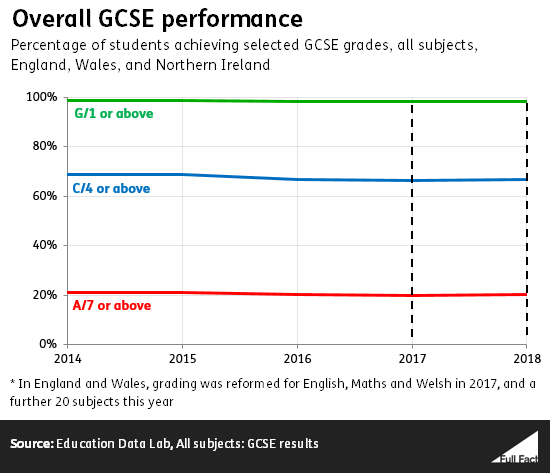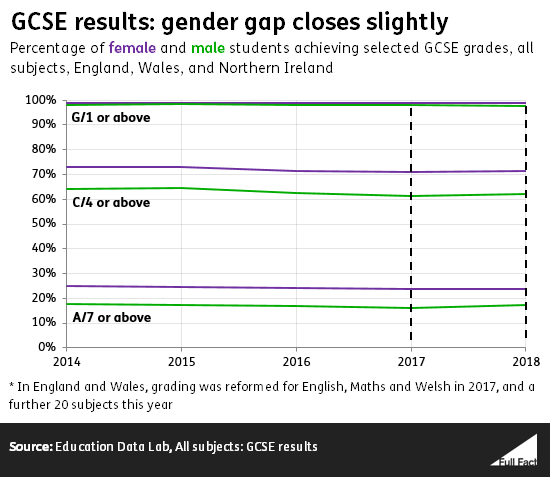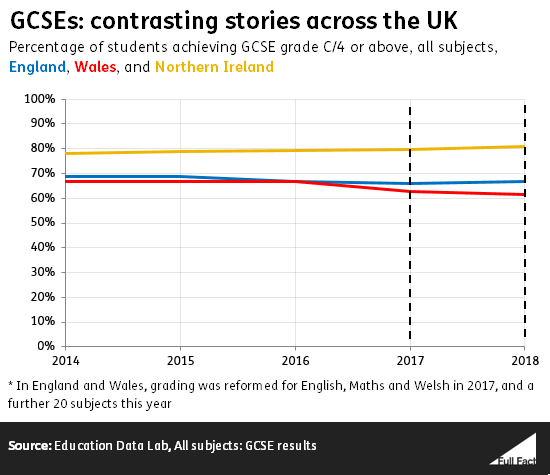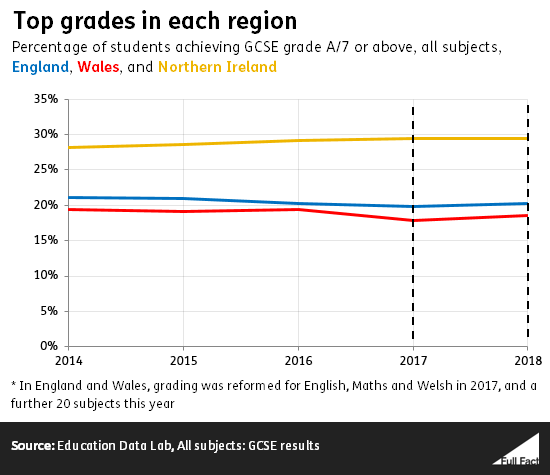GCSE results: boys drive slightly improved performance
This year’s GCSE results were released today. Overall, there has been a slight pick-up in performance levels, after a couple of years of decline in pupils achieving higher grades.
However, as with our assessment of last week’s A-Level results, it’s important to remember that any reported changes are likely to be much less dramatic than they sound.
A rise in, say, the number of pupils achieving top grades, is likely to be a matter of a few percentage points. Changes in performance also need to be taken in a longer term context to be properly understood, not looked at compared to last year in isolation.
Those warnings aside, there are a couple of interesting trends to note. A pick up in overall achievement of grade A/7 and above, or C/4 and above (we’ll explain the new grading system in a moment) is driven by boys in particular. They’ve shown a slight increase in achievement of these grades, while achievement among girls is much the same as in previous years.
Some of the biggest declines in performance are in Wales—which has seen a five percentage point drop in achievement of grade C/4 over the past two years.
The data analysed in this article all comes from the FFT Education Datalab, and covers England, Wales, and Northern Ireland (most students in Scotland don’t sit GCSEs).
Honesty in public debate matters
You can help us take action – and get our regular free email
What’s happened to the grading system?
20 subjects in England and Wales were assessed based on a new format this year. Three subjects: English, Maths, and Welsh, already made the switch last year.
The new format is mainly assessed by exam, with a reduced amount of coursework. Courses are no longer divided into modules, and students take all their exams in one period at the end of the course. It’s also designed to include “new, more demanding content”.
A new grading system has been introduced for the new format of assessment (from 9 to 1, instead of A* to G), which is designed to “allow greater differentiation between students”. Grades 7-9 are equivalent to the old A-A*, while 4-6 equates to C-B.
Ofqual—the body that regulates examinations in England—has previously said that the distribution of grades should be broadly the same under the new grading system. It uses predictions based on students’ prior attainment to ensure this.
Overall performance
This year has seen an increase of about half a percentage point in the level of students in England, Wales and Northern Ireland achieving grade A/7 or above, and C/4 or above.
This represents a slight pick-up in performance, after a decline in the previous two years. A/7 achievement fell by around one percentage point from 2015 to 2017, while C/4 achievement fell by about three percentage points.
Performance among boys has picked up this year
Overall, girls continue to perform better than boys, particularly at the higher grade levels.
But performance amongst boys has picked up notably this year, after a couple of years of decline. Both boys and girls saw dips in the proportion achieving grade A/7 or above from 2015 to 2017 (by around one percentage point each). Since then girls’ performance has stabilised while boys’ performance is up by around one percentage point.
It’s a similar story at grade C/4 or above. After a drop of around three percentage points from 2015 to 2017, boys’ performance picked up by around one percentage point this year. Girls saw a smaller version of the same trend: the drop was about two percentage points from 2015 to 2017, followed by a rise of about half a percentage point.
A tale of two regions
Performance across the different regions in the UK is where we see some of the biggest fluctuations this year. Overall, Northern Ireland continues to significantly outperform England and Wales.
The difference is most stark among students achieving grade C/4 or above. The level rose by about one and a half percentage points in Northern Ireland, half a percentage point in England, and it fell by just over one percentage point in Wales. The drop in performance in Wales is most notable—the 1.2 percentage point fall this year follows a 3.8 percentage point fall the year before. England sees a pick-up of 0.5 percentage points, after falling almost three percentage points in the previous two years.
There’s better news for Wales in terms of performance at the very highest grades. Achievement of grade A/7 or above rose by about half a percentage point this year, after a fall of one and a half percentage points the year before (it was pretty flat prior to this). England saw a rise of half a percentage point after a few years of decline, while Northern Ireland stayed broadly flat after a few years of slight increases.